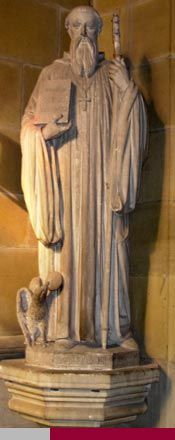ABOUT ST BENEDICT
In the sixth century, St Benedict was one of many abbots who wrote a Rule for monks. He had established monasteries at Subiaco and Monte Cassino in Italy. These were destroyed by the barbarian invasions but a few manuscripts of his Rule survived and were carried by refugees to other monasteries in Rome, North Italy, and Gaul (modern day France). In the course of two centuries the use of the Rule spread, and it was largely due to the influence of Charlemagne that it acquired a monopoly in the West. In this way, St Benedict came to be considered the founder of the 'Black Monks' of the Middle Ages, called from that time the ‘Order of St Benedict’.
The Subiaco Cassinese Congregation

More about St Benedict
- The Orders
Each independent house of the Order is a separate family ruled by an Abbot and has its own novitiate.
The work of each house is centred on the Divine Office or public prayer, recited or sung in choir at regular intervals throughout the day. This work is common to and characteristic of all Benedictine houses, whether of monks or nuns.
- A Choir Monk
A Choir Monk after his profession may be ordained priest, once he has completed his novitiate, two years of philosophy and four years of theology, but this need not always be the case. Indeed, there is no evidence to suggest that St Benedict was ordained.
- Development over time
Through the centuries since, the Order has spread to all continents.
Although all the monasteries base their life on St Benedict’s Holy Rule, local conditions and the varying types of each climate made it inevitable that certain modifications and applications would be found necessary.
St Benedict in fact makes provision for this in the Rule, authorising the abbot to adapt the Divine Office, the measure of food and drink and so on according to local conditions. These modifications and applications of the Rule, often being influenced by local or spiritual considerations were eventually drawn up as 'constitutions' on the Rule, which were then ratified by the Holy See.
- Sant Anselmo
With the Apostolic Letter of His Holiness Pope Leo XIII 'Summum Semper' given on 12th July 1893, the Congregations of the Order were united into a confederation in an attempt to centralise the Order. The Benedictine Confederation, which numbers twenty congregations, is presided over by the Abbot Primate. The Abbot Primate is elected to a primacy of honour by his fellow abbots and conventual priors from throughout the world, and resides at the monastery of Sant Anselmo in Rome.
- The Rule of St Benedict
You can read the whole Rule of St Benedict here.




